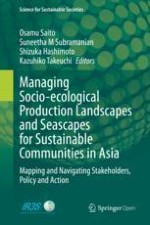9.1 Summary of the Book
Chapter | Objectives | Materials/study sites | Methods/tools | Spatial scale | Key actors |
|---|---|---|---|---|---|
Chapter 2
| Mapping the policy interventions on marine social-ecological systems | A case study of the Sekisei Lagoon, Southwest Japan | The Social-Ecological Systems (SES) schematic: an integrated diagram of the inter-relationships between the main ecosystem structures, ecosystem functions, ecosystem use types, and stakeholders | Local scale | Includes central and local governments, fishermen, fish processers, marine cultural services users, and marine energy/resource developers |
Chapter 3
| Evaluating tourist opinions concerning participating in invasive carp removal in nature-based tourism | An experimental survey in Amami Oshima, Japan (343 questionnaires returned by mail) | A choice experiment on canoe tours to evaluate tourists’ willingness to pay for tour options as a means of promoting canoe tours | Island scale | Tourists, tour operators, and the local government |
Chapter 4
| Backcasting scenario-making for sustainable urban transformation | A case study in Toyama, Japan | Backcasting scenario-making via a citizen participatory workshop | Local (city) scale | Citizen participants |
Chapter 5
| Proposing actions and policy alternatives to reverse the process of degradation and to move toward transformative harmonious human–nature interactions | A case study of the Sundarbans in Bangladesh | A conceptual framework of SEPLS, human sociality, and sustainability Multiple evidence-based (MEB) approaches | A transboundary mangrove ecosystem on the great delta of the Ganges | Indigenous peoples and local communities (IPLCs), property right owners, governments, factories, and shrimp cultivators |
Chapter 6
| Lessons from “Indicators of Resilience in SEPLS” | A total of 34 landscapes and seascapes around the world | The indicators of resilience in SEPLS (20 resilience indicators) | Local (community) scale | Local community, indigenous and local knowledge holders, local governments, and policy makers |
Chapter 7
| Reviewing place-based solutions for conservation and the restoration of social-ecological production landscapes and seascapes in Asia | A total of 88 case studies from the International Partnership for the Satoyama Initiative (IPSI) in the South, East, and Southeast Asian regions | A societal-based solution scanning approach | From local to national scales | Academia, public sector, community, and non-governmental (civic and private sectors) |
Chapter 8
| Reviewing the effectiveness of biodiversity SPIs | A total of 96 SPI studies worldwide | Systematic literature review Key features of SPIs | From local to global scales | Government and academia as facilitators of SPIs |
9.2 Implications for Transformative Changes toward Sustainability
Leverage points | Relevant chapters | Relevant approaches and insights from the chapters |
|---|---|---|
(1) Visions of a good life | – Participatory approach of backcasting scenario-making (Chap. 4) – MEB approaches (Chap. 5) – Importance of IPLCs in the conservation and management process (Chap. 5) | |
(2) Total consumption and waste | – SES schematics can holistically summarize the main ecosystem structures, functions, use types, and stakeholders (Chap. 2) – Perception of nature-based tourism for the removal of invasive species (Chap. 3) – The resilience indicator toolkit approach helps communities to define their aspirations, take stock of their ecosystem integrity and resources, and identify strategies to achieve goals under indicators that are defined by the community and suited to their context (Chap. 6) | |
(3) Values and action | ||
(4) Inequalities | – The resilience assessment includes indicators for governance and social equity such as social equity (including gender equity) (Chap. 6) – The inclusion of community-based mapping exercises into resilience assessment workshops (Chap. 6) – Inclusion is one of the subcategories under institutional and governance solutions (Chap. 7) – Credibility, relevance, and legitimacy of SPIs (Chap. 8) – Inclusion of policy perspectives into research projects (Chap. 8) | |
(5) Justice and inclusion in conservation | ||
(6) Externalities and telecoupling | Chapter 2
| – SES schematics can capture externalities and telecoupling by covering a wide range of users beyond the target landscapes and seascapes including the transport and energy/resource development sectors (Chap. 2) |
(7) Technology, innovation, and investment | – Innovation and diversification of livelihood patterns including innovative techniques in agriculture (Chap. 5) – Technological solutions are one of the key solution types to reduce the harmful impacts of various drivers of ecosystem change, as well as underinvestment in the development and diffusion of technologies, and could increase the efficiency of resource or ecosystem use (Chap. 7) | |
(8) Education and knowledge generation and sharing | – SES schematics can visually facilitate role sharing and knowledge sharing between different relevant stakeholders across scales (Chap. 2) – Knowledge and cognitive solutions are another key solution type to address insufficient knowledge or the poor use of existing knowledge concerning ecosystem services and addresses information gaps and incorporates other forms of knowledge and information (Chap. 7) |
